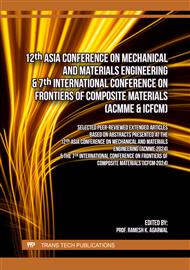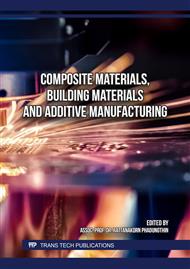[1]
Schmitz, A. (2020). Effect of Three-Dimensional Printing with Nanotubes on Impact and Fatigue Resistance. Journal of Engineering Materials and Technology, 142(2), 024501
DOI: 10.1115/1.4044963
Google Scholar
[2]
Vijayan, V., Kumar, S. A., Gautham, S., & Masthan, M. M. (2021). Design and analysis of prosthetic foot using additive manufacturing technique. Materials Today: Proceedings.
DOI: 10.1016/j.matpr.2020.07.195
Google Scholar
[3]
Iijima, S. (1991). Helical microtubules of graphitic carbon. Nature (354), 56-58.
DOI: 10.1038/354056a0
Google Scholar
[4]
Novoselov, K. S., Geim, A. K., Morozov, S. V., Jiang, D., Zhang, Y., Dubonos, S. V., et al. (2004). Electric Field Effect in Atomically Thin Carbon Films. Science, 306(5696), 666-669.
DOI: 10.1126/science.1102896
Google Scholar
[5]
Baughman, R. H., Zakhidov, A. A., & de Heer, W. A. (2002). Carbon nanotubes--the route toward applications. Science, 297(5582), 787-792.
DOI: 10.1126/science.1060928
Google Scholar
[6]
Dresselhaus, M. S., Dresselhaus, G., & Saito, R. (1995). Physics of carbon nanotubes. Carbon, 33(7), 883-891.
DOI: 10.1016/0008-6223(95)00017-8
Google Scholar
[7]
Thostenson, E. T., Li, C., & Chou, T.-W. (2005). Nanocomposites in context. Composites Science and Technology, 65(3), 491-516.
DOI: 10.1016/j.compscitech.2004.11.003
Google Scholar
[8]
Yakobson BI, Brabec CJ, Bernholc J. (1996). Nanomechanics of carbon tubes: instabilities beyond linear response. Phys Rev Lett; 76(14): 2511–4.
DOI: 10.1103/physrevlett.76.2511
Google Scholar
[9]
Ru CQ. (2000). Effective bending stiffness of carbon nanotubes. Phys Rev B; 62(15):9973–6.
DOI: 10.1103/physrevb.62.9973
Google Scholar
[10]
Ru CQ. (2000). Elastic buckling of single-walled carbon nanotube ropes under high pressure. Phys Rev B; 62(15):10405–8.
DOI: 10.1103/physrevb.62.10405
Google Scholar
[11]
Odegard GM, Gates TS, Nicholson LM, Wise KE. (2002). Equivalent-continuum modeling of nano-structured materials. Compos Sci Technol;60(14):1869–80
Google Scholar
[12]
Meo M, Rossi M. A molecular-mechanics based finite element model for strength prediction of single wall carbon nanotubes. Mater Sci Eng A; 454–455:170–7.
DOI: 10.1016/j.msea.2006.11.158
Google Scholar
[13]
Rossi M, Meo M. (2009). On the estimation of mechanical properties of single-walled carbon nanotubes by using a molecular-mechanics based FE approach. Compos Sci Technol; 69(9): 1394–8.
DOI: 10.1016/j.compscitech.2008.09.010
Google Scholar
[14]
Krishnan, A., Dujardin, E., Ebbesen, T. W., Yianilos, P. N., & Treacy, M. M. J. (1998). Young's modulus of single-walled nanotubes. Physical Review B - Condensed Matter and Materials Physics, 58(20), 14013-14019.
DOI: 10.1103/physrevb.58.14013
Google Scholar
[15]
Tombler, T. W., Zhou, C., Alexseyev, L., Kong, J., Dai, H., Liu, L., . . . Wu, S. Y. (2000). Reversible electromechanical characteristics of carbon nanotubes under local-probe manipulation. Nature, 405(6788), 769-772
DOI: 10.1038/35015519
Google Scholar
[16]
Liew, K. M., He, X. Q., & Wong, C. H. (2004). On the study of elastic and plastic properties of multi-walled carbon nanotubes under axial tension using molecular dynamics simulation. Acta Materialia, 52(9), 2521-2527
DOI: 10.1016/j.actamat.2004.01.043
Google Scholar
[17]
Lu, J. P. (1997). Elastic Properties of Carbon Nanotubes and Nanoropes. Physical Review Letters, 79(7), 1297-1300
DOI: 10.1103/PhysRevLett.79.1297
Google Scholar
[18]
Hernandez, E., Goze, C., Bernier, P., & Rubio, A. (1998). Elastic properties of C and BxCyNz composite nanotubes. Physical Review Letters, 80(20), 4502-4505.
Google Scholar
[19]
Jin, Y., & Yuan, F. G. (2003). Simulation of elastic properties of single-walled carbon nanotubes. Composites Science and Technology, 63(11), 1507-1515
DOI: 10.1016/s0266-3538(03)00074-5
Google Scholar
[20]
Shen, L., & Li, J. (2004). Transversely isotropic elastic properties of single-walled carbon nanotubes. Physical Review B - Condensed Matter and Materials Physics, 69(4), 454141-4541410.
DOI: 10.1103/physrevb.69.045414
Google Scholar
[21]
Gupta, S. S., & Batra, R. C. (2008). Continuum structures equivalent in normal mode vibrations to single-walled carbon nanotubes. Computational Materials Science, 43(4), 715-723
DOI: 10.1016/j.commatsci.2008.01.032
Google Scholar
[22]
Giannopoulos, G. I., Kakavas, P. A., & Anifantis, N. K. (2008). Evaluation of the effective mechanical properties of single walled carbon nanotubes using a spring based finite element approach. Computational Materials Science, 41(4), 561-569. Gupta, S. S., & Batra, R. C. (2008). Continuum structures equivalent in normal mode vibrations to single-walled carbon nanotubes. Computational Materials Science, 43(4), 715-723. doi: http://dx.doi.org/10.1016/j.commatsci. 2008.01.032
DOI: 10.1016/j.commatsci.2007.05.016
Google Scholar
[23]
Cheng, H. C., Liu, Y. L., Hsu, Y. C., & Chen, W. H. (2009). Atomistic-continuum modeling for mechanical properties of single-walled carbon nanotubes. International Journal of Solids and Structures, 46(7-8), 1695-1704
DOI: 10.1016/j.ijsolstr.2008.12.013
Google Scholar



